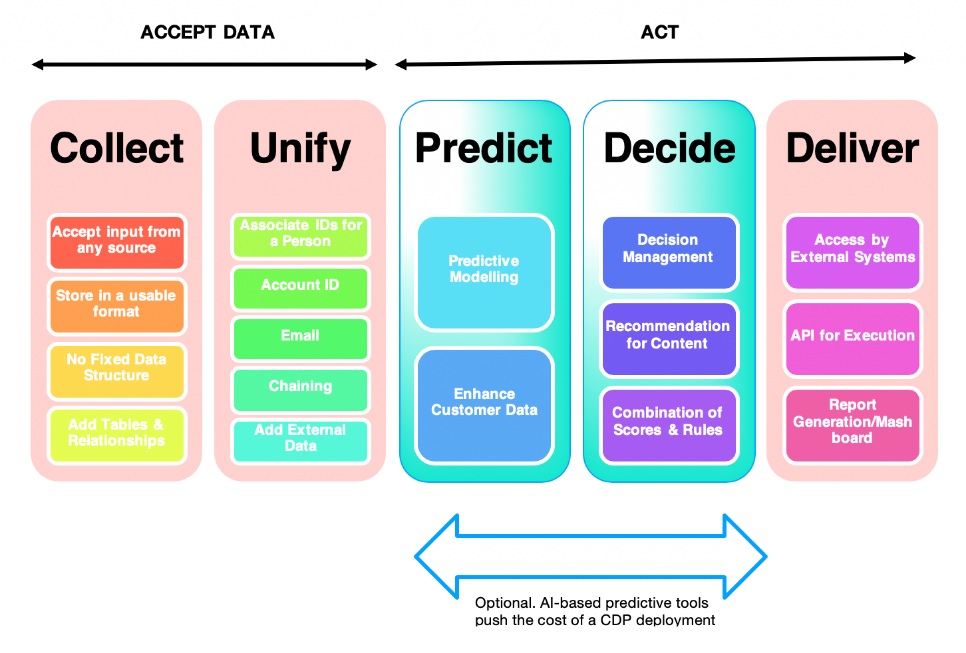
Hindsight fuels Foresight 7 reasons why you should look at CDP (Part 2)
Predictive Marketing Automation
Next best action decision
Next Best Action decision is a much-awaited evolution of CDP platforms. As the platform ingests more and more data across sources, we have an abundance of insights that can be used to determine our next actions.
Not as simple as it sounds, this involves a lot of customer behavior data, response to channels and messages, and predictive analytics. Once actioned, Next Best Action decision system can help you forecast your CDJ and pepper the journey with the right messages at the right time, thereby building seamless customer experience.
If you are using a CDP, you are already ingesting customer data as well as response data – basically, your customer’s response or lack of it to your communication. Let us define it as the “What” of your customer interaction.
After this, where and when does your customer want to engage with you next? To find answers to this, you need to look at customer behavior data and causal analytics. Predictive Marketing Automation helps you understand causal relationships. Perform experiments on control and test groups, match and compare the results and roll out the “next best action” based on these results.
An advanced CDP can help you study multiple “behavioral cohorts”, chart the CDJ for each cohort, milestone mapping the key moments of inflection along with the channels, tactics, and communication. Using Machine Learning on this data sets helps you derive propensity or intent scores. Each customer can be given a propensity or intent score.
By replacing frequency analysis with propensity modeling, which uses far more data points in real-time, you can more accurately forecast customer behavior and trigger the next best action, which is more likely to result in a positive outcome.
By studying customer behavior data and using the power of predictive marketing automation, the where and when becoming clearer.
Dynamic segmentation
Unlike a static segment which remains rigid (a fixed set of audience based on parameters defined at a point in time), dynamic segmentation yields an organic segment in which users move in and out based on conditions and behavior. So, in effect, a dynamic segment adapts – it used real-time data to continuously update your audience cohorts as the system ingests fresh information as it comes in. You don’t have to manually export your segments each time you execute a marketing intervention. Instead, your CDP will pass on the most relevant segment at-that-point-in-time to your marketing engines. For this to happen, you need to be able to track audience behavior across multiple touchpoints and unify all of this data which is what a CDP does exceedingly well. Imagine sending out a communication to users who haven’t engaged in the last 30 days while excluding users who have responded to previous such communication, instead triggering a different set of responses to them alone, based on their response.
No Need for IT
A CDP should be manageable by a marketer. That is almost a prerequisite. As a marketer, that is a big one because it allows you complete control over the tool and processes with very little dependence on a team whose processes and motivations may be completely at variance with your own. Mistake not, you need IT’s help in the initial implementation but once you have it done, CDP’s prebuilt modules or apps reduce the complexity of customization. A good CDP will have worked hard to create a great user experience.
5 stages of a customer lifecycle
Anonymous, Prospect, Customer, Repeat Customer, and Profitable.
These are the 5 customer states that you most care about. Your marketing and CRM interventions should fundamentally seek to move your customers from one state to the next OR address a deviation in progress from one state to another. To do that effectively, you need information at each stage to be aggregated, analyzed, and filtered before it is used for the “Next Best Action”.
Your CDP should not be a monolith performing the data aggregation and analytics function alone. Instead, look for a CDP that gives you a suite of extensions or applications that can meaningfully exploit the intelligence derived out of it.

Before I end, a few important points.
- CDP is an organic, live database of your customer information. It is meant to be clean and open.
- CDP is built to be owned and operated by marketers. Therefore, it follows that CDP’s failure is not a tech failure. It is normally a marketer’s folly
- In my experience, many failures arise because marketers don’t understand the need for specialist skills and roles that are necessary to make technology work for marketing
- CDP is not the silver bullet. What you do with it, maybe.
- You’ll be surprised how messy your data is. The best time to reset it was yesterday. The next best time is today.
About me
As a marketer, I’ve grown from pushing my gut instincts to an abiding respect for data as the only source of truth. At Langoor Havas Enterprise, I consult and guide organizations in their journey towards building an efficient and effective marketing organization.